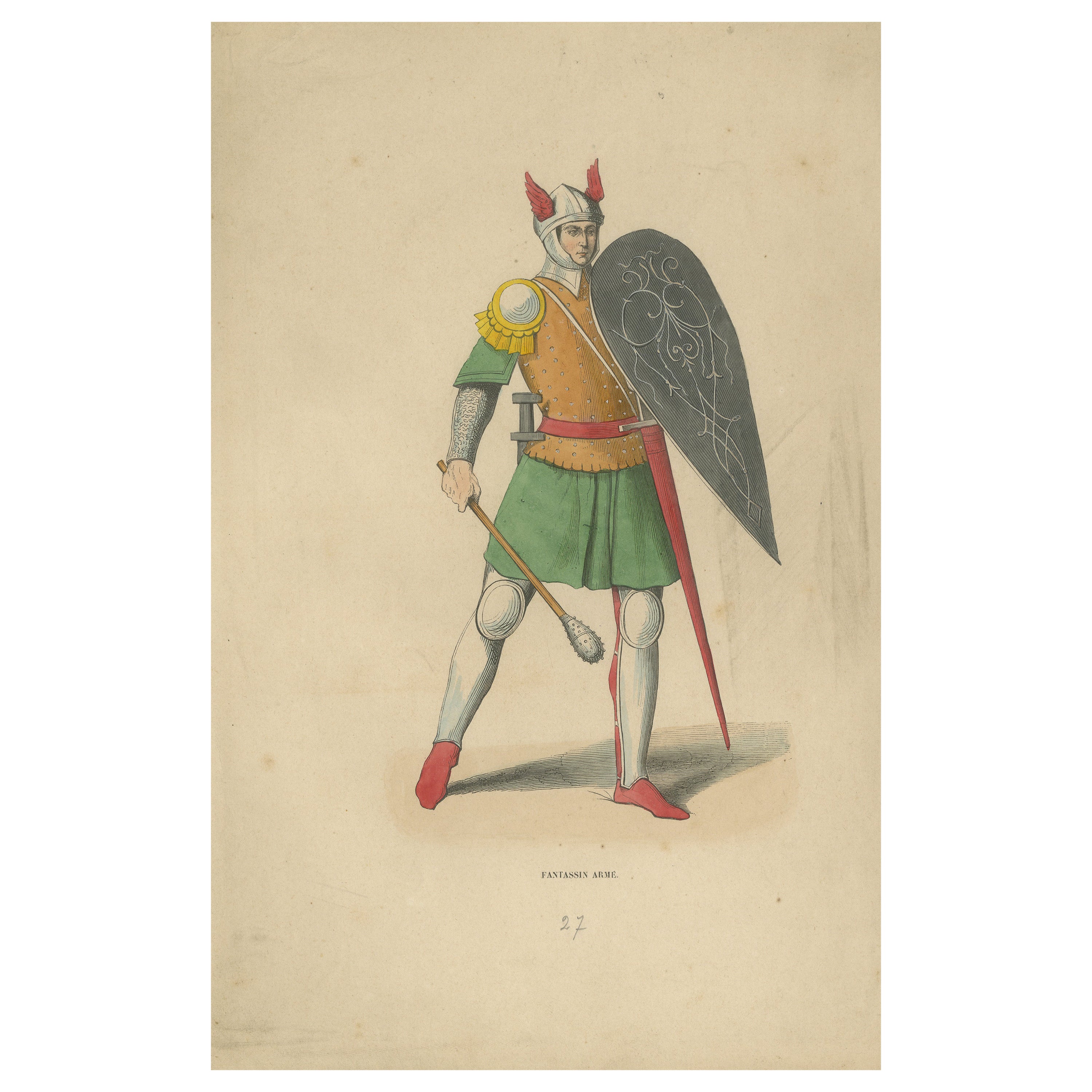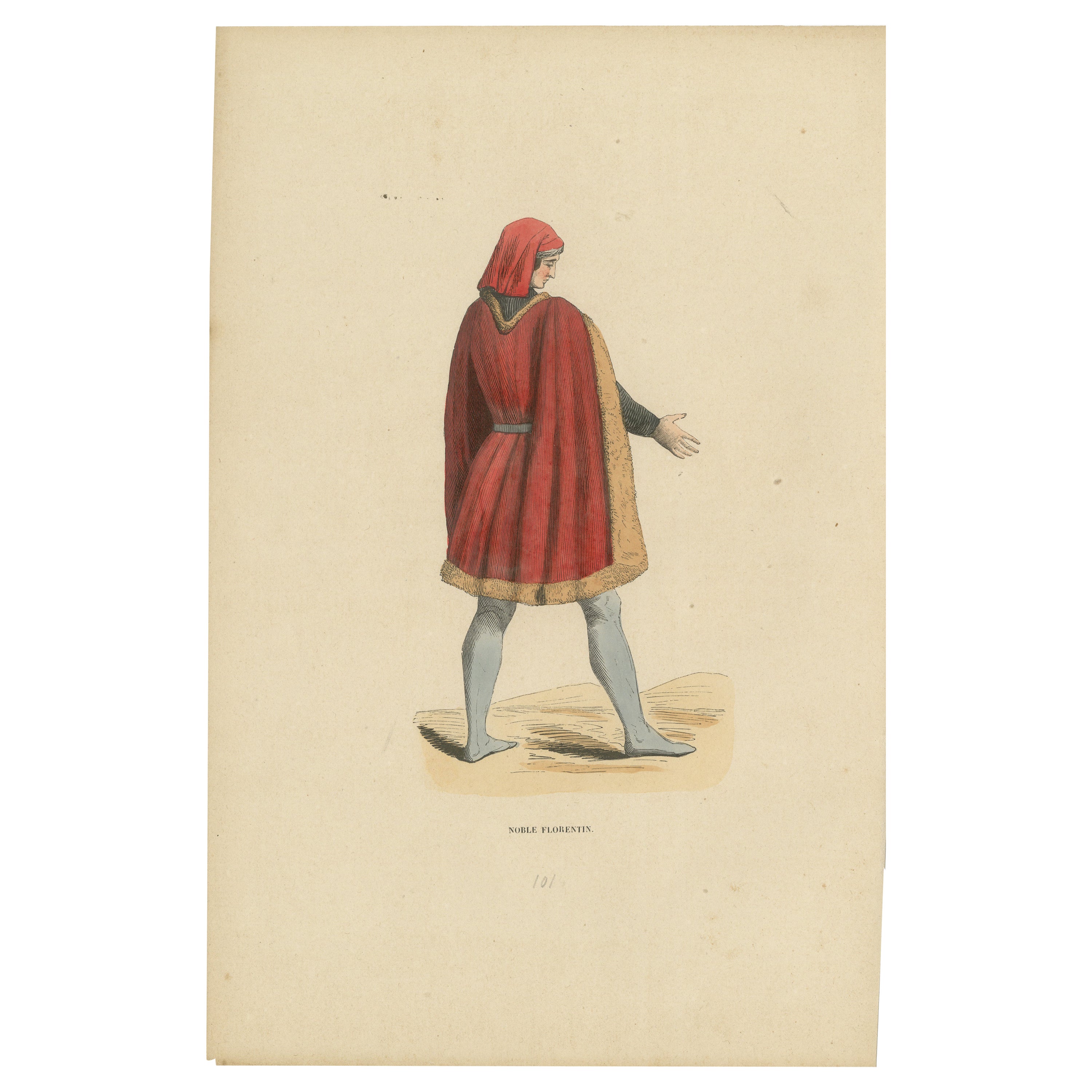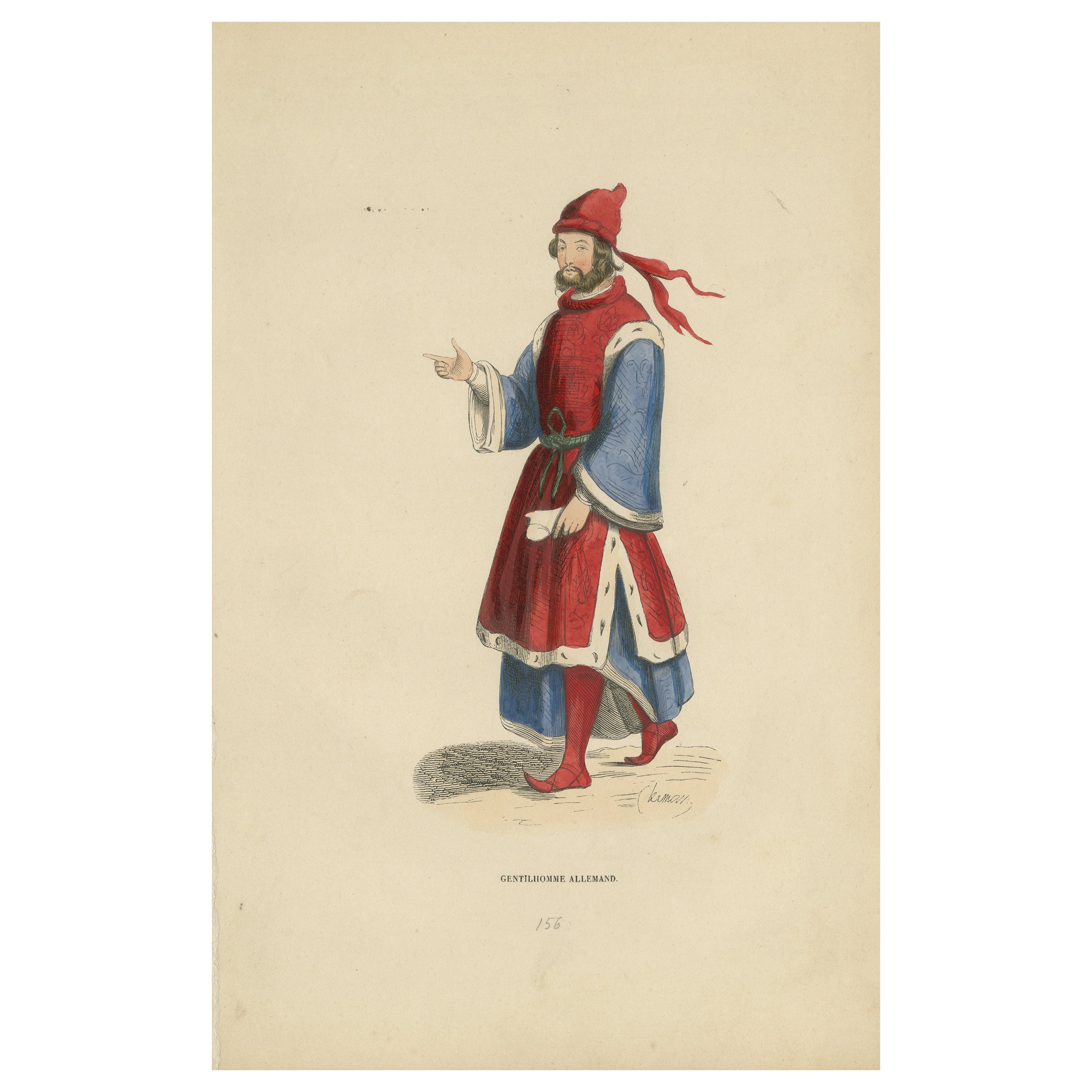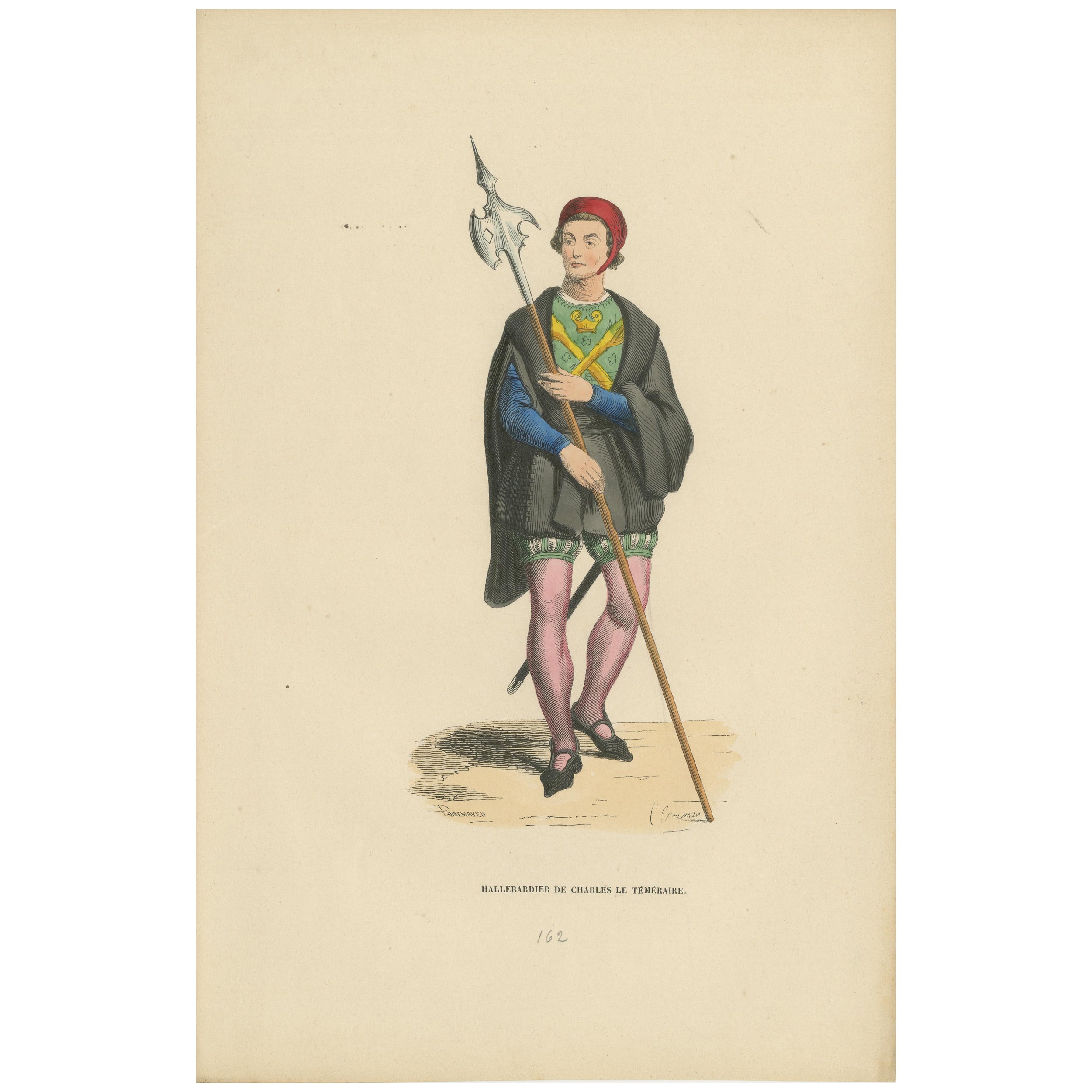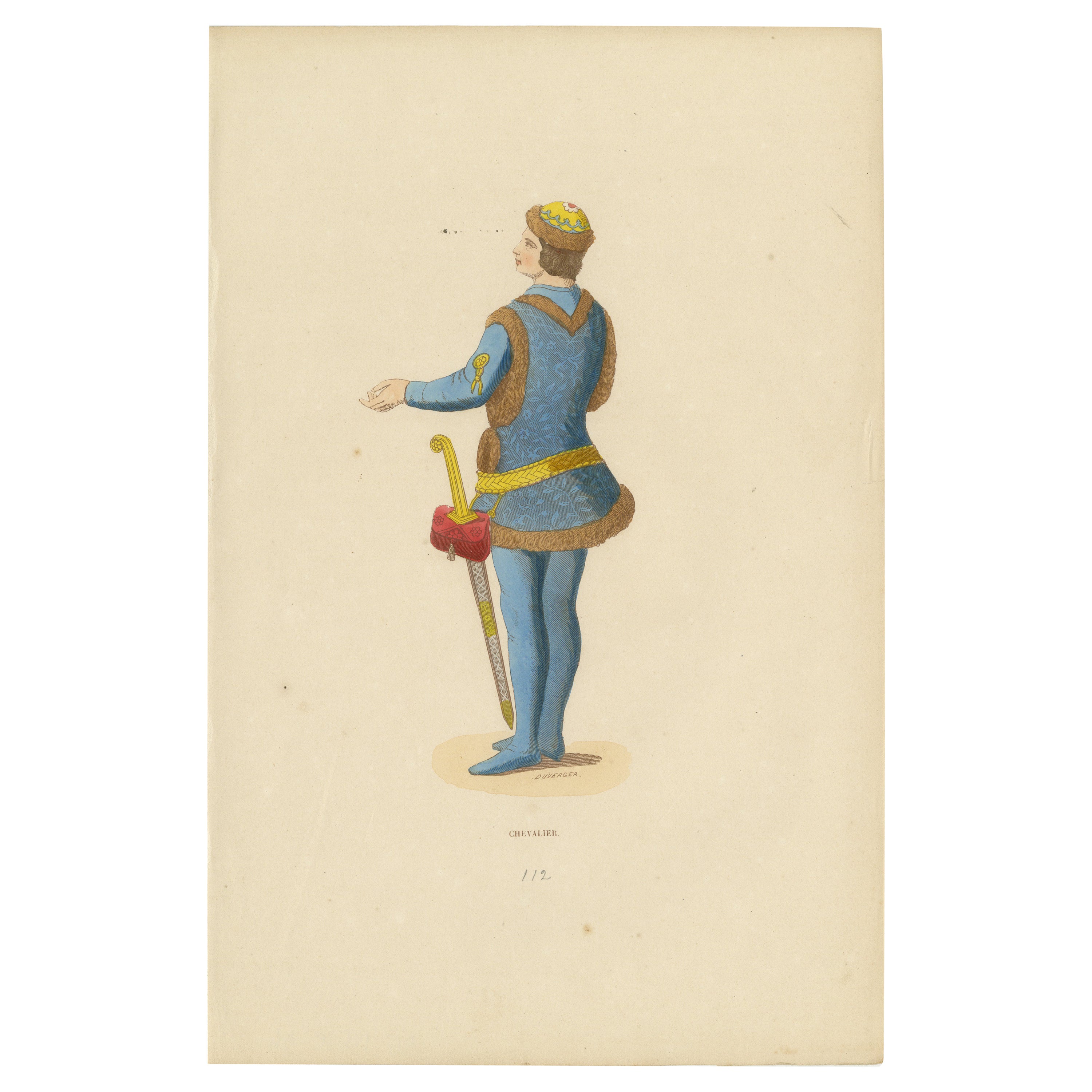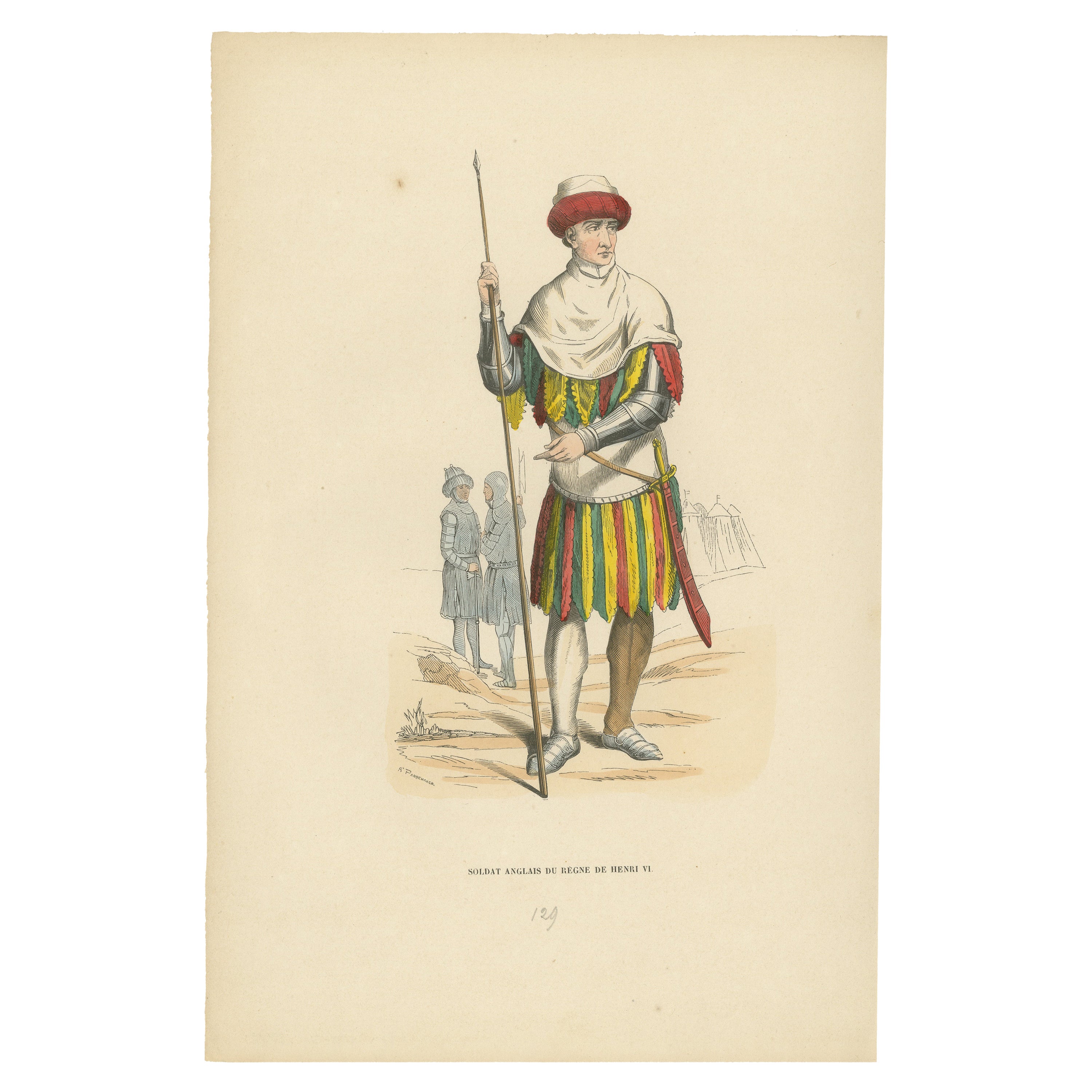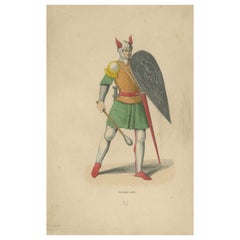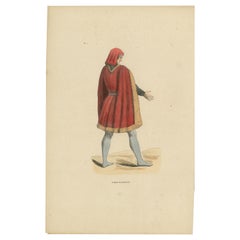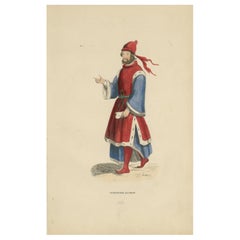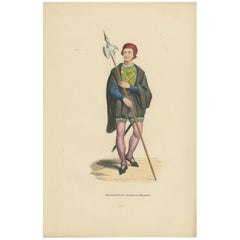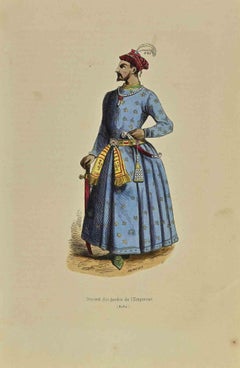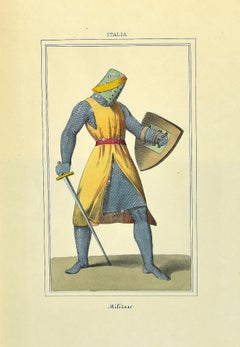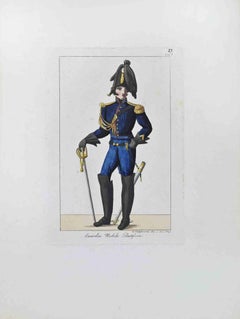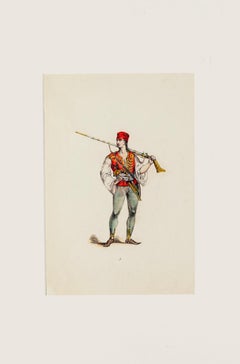Items Similar to Vigilance in Blue: 15th Century Military Garb, 1847
Want more images or videos?
Request additional images or videos from the seller
1 of 6
Vigilance in Blue: 15th Century Military Garb, 1847
$172.68
$215.8520% Off
£128.46
£160.5720% Off
€144
€18020% Off
CA$236.46
CA$295.5820% Off
A$262.91
A$328.6420% Off
CHF 137.28
CHF 171.6020% Off
MX$3,200.28
MX$4,000.3520% Off
NOK 1,751.61
NOK 2,189.5120% Off
SEK 1,641.17
SEK 2,051.4720% Off
DKK 1,096.19
DKK 1,370.2420% Off
Shipping
Retrieving quote...The 1stDibs Promise:
Authenticity Guarantee,
Money-Back Guarantee,
24-Hour Cancellation
About the Item
Title: "Vigilance in Blue: 15th Century Military Garb"
Description: This original handcolored historical illustration presents a military figure from the 15th century, clad in an ornate costume that showcases both functionality and the aesthetic sensibilities of the time. The figure stands with a commanding presence, holding a staff that indicates his readiness and status as a person of authority.
His outfit is richly decorated with intricate patterns and bold, contrasting colors. The deep blue tunic is both practical for mobility and striking to the eye, adorned with golden circular embellishments that catch the light, indicating a rank of distinction. Over this, a white cloak with a blue lining drapes elegantly, perhaps indicating a rank or a specific role within the military hierarchy.
The headgear, a blue hood with golden accents, serves the dual purpose of protection and symbol of status. The large, decorative clasps at the shoulder not only secure his cloak but also serve as a display of wealth and power.
His leggings are armored for protection, with patterns that complement the grandeur of his tunic. The soft pink sash around his waist adds a touch of color to the ensemble, perhaps signifying a particular allegiance or order within the military.
This portrayal is a window into the martial fashion of the period, where even the warriors dressed with an eye for detail that went beyond mere protection, embedding symbolism and status into every thread of their attire. It reflects the importance of visual impact on the battlefield, where one's appearance could inspire both allies and intimidate opponents.
The colors have a nice glow over them. Historically, egg whites, known as glair, and sometimes egg yolk were indeed used in illumination and painting, particularly in manuscripts, to give colors a brighter appearance and to add a sheen or gloss to the work. This technique was quite common during the Middle Ages and into the Renaissance.
Egg whites can be applied as a varnish over pigments to enhance their brightness and to protect the colors. This application could make the colors appear more vivid and also add a slight glossy sheen to the surface of the image.
Egg yolk, on the other hand, was commonly used as a binding agent in paint. It forms the basis of tempera paint, a medium that was widely used before the advent of oil painting. Egg yolk helps to create a durable and long-lasting color that adheres well to various surfaces.
In the context of the print from 1847, it's less likely that egg whites or yolks were used directly on the print, as by that time, commercial printing processes would have been more advanced and less reliant on such manual methods. However, if this print is a representation of an earlier style or is meant to mimic the appearance of hand-painted manuscripts, the original artists might have employed techniques or materials that gave a similar effect to those achieved with egg-based binders and varnishes.
- Dimensions:Height: 10.63 in (27 cm)Width: 7.09 in (18 cm)Depth: 0 in (0.02 mm)
- Materials and Techniques:
- Period:
- Date of Manufacture:1847
- Condition:Good. Overal light toning and light soiling but the image itself clean and hand-colored almost 200 years ago and still in expliciet colors. Aged paper with typically warm, yellowish-brown hue, mostly around the edges. Study the images carefully.
- Seller Location:Langweer, NL
- Reference Number:Seller: BG-13635-781stDibs: LU3054337906012
About the Seller
5.0
Recognized Seller
These prestigious sellers are industry leaders and represent the highest echelon for item quality and design.
Platinum Seller
Premium sellers with a 4.7+ rating and 24-hour response times
Established in 2009
1stDibs seller since 2017
2,510 sales on 1stDibs
Typical response time: <1 hour
- ShippingRetrieving quote...Shipping from: Langweer, Netherlands
- Return Policy
Authenticity Guarantee
In the unlikely event there’s an issue with an item’s authenticity, contact us within 1 year for a full refund. DetailsMoney-Back Guarantee
If your item is not as described, is damaged in transit, or does not arrive, contact us within 7 days for a full refund. Details24-Hour Cancellation
You have a 24-hour grace period in which to reconsider your purchase, with no questions asked.Vetted Professional Sellers
Our world-class sellers must adhere to strict standards for service and quality, maintaining the integrity of our listings.Price-Match Guarantee
If you find that a seller listed the same item for a lower price elsewhere, we’ll match it.Trusted Global Delivery
Our best-in-class carrier network provides specialized shipping options worldwide, including custom delivery.More From This Seller
View AllVigilance in Arms: A Renaissance Infantryman Prepared for Battle, 1847
Located in Langweer, NL
The image for sale depicts a figure labeled "Fantassin armé," which translates to "Armed Infantryman." The infantryman is shown in a dynamic pose, holding a shield and a mace, indica...
Category
Antique 1840s Prints
Materials
Paper
$162 Sale Price
20% Off
Florentine Nobleman of the Middle Ages, 1847
Located in Langweer, NL
Title: "Civilian Costume at the End of the 15th Century"
Description: The image is a print from a series the "Costume du Moyen Age" dated 1847, and titled "Costume Civil de la Fin du XVe Siècle," which translates to "Civilian Costume at the End of the 15th Century." It showcases a man of status, possibly a noble or a wealthy burgher, standing in a poised and confident manner.
He is attired in an ornate cloak covered in a complex pattern of fleur-de-lis and cross motifs, indicative of wealth and possibly a connection to royalty or high social rank. The cloak is open at the front to reveal a blue doublet with a belt, and he wears red hose—a fashion staple of the late medieval period. His footwear is also red, which stands out against the more subdued tones of his outfit.
On his head, he sports a fur-trimmed hat, adding to the luxuriousness of his attire. In one hand, he holds a long staff, which serves as both a walking aid and a symbol of authority. His other hand rests on the hilt of a dagger, further indicating his readiness to defend his status or engage in the political or civic matters of his time.
The artist has skillfully rendered the textiles and accessories with great care, emphasizing the fashion and social cues of the late 15th-century European society.
The colors have a nice glow over them. Historically, egg whites, known as glair, and sometimes egg yolk were indeed used in illumination and painting, particularly in manuscripts, to give colors a brighter appearance and to add a sheen or gloss to the work. This technique was quite common during the Middle Ages...
Category
Antique 1840s Prints
Materials
Paper
$124 Sale Price
20% Off
Noble Bearing: A German Gentleman in Medieval Attire, 1847
Located in Langweer, NL
Title: "Noble Bearing: A German Gentleman in Medieval Attire from 'Costume du Moyen Âge'"
Description: This 1847 lithograph from the esteemed collection "Costume du Moyen Âge" showc...
Category
Antique 1840s Prints
Materials
Paper
$172 Sale Price
20% Off
Guardian of the Realm: A Halberdier of Charles the Bold, Lithograph of 1847
Located in Langweer, NL
This antique print for sale portrays a halberdier from the time of Charles the Bold, also known as Charles the Rash, who was Duke of Burgundy from 1467 to 1477. The halberdier is dressed in a traditional military garb indicative of the late Middle Ages. He stands poised with a halberd, a combined spear and battle-axe weapon that was a common part of the infantry's arsenal during that period.
His attire is both functional and symbolic, featuring a tabard with what appears to be a heraldic emblem over a chainmail armor...
Category
Antique 1840s Prints
Materials
Paper
$172 Sale Price
20% Off
Medieval Knight: Heraldry and Valor in 15th Century Garb, 1847
Located in Langweer, NL
Title: "Chevalier" (Knight)
Description: This 1847 hand-colored engraving from the "Costume du Moyen Age" series depicts a "Chevalier," the French term for a knight. The image illus...
Category
Antique 1840s Prints
Materials
Paper
$143 Sale Price
20% Off
Martial Valour of an English Soldier in the Reign of Henry VI, Published in 1847
Located in Langweer, NL
Title: "Martial Valour of an English Soldier in the Reign of Henry VI: An Illustration from 'Costume du Moyen Âge'"
Description: This 1847 lithograph from "Costume du Moyen Âge" por...
Category
Antique 1840s Prints
Materials
Paper
$163 Sale Price
20% Off
You May Also Like
General of the Emperor’s Guards - Lithograph by Auguste Wahlen - 1844
Located in Roma, IT
General of the Emperor’s Guards is a lithograph made by Auguste Wahlen in 1844.
Hand colored.
Good condition.
At the center of the artwork is the original title "General des garde...
Category
1840s Modern Figurative Prints
Materials
Lithograph
Soldier - Original Lithograph on Paper - 19th Century
Located in Roma, IT
Soldier is an original hand-colored lithograph on paper realized by an Anonymous artist of the XIX century, it represents a soldier in Italian traditional military costume through ha...
Category
19th Century Modern Figurative Prints
Materials
Lithograph
The Noble Pontifical Guard - Etching by Giuseppe Capparoni - 1827
Located in Roma, IT
The Noble Pontifical Guard is an Artwork realized in 1827 by the Engraver, Giuseppe Capparoni (Rome 1800- 1879).
Etching hand colored on ivory paper. Signed on plate and dated on th...
Category
1820s Modern Portrait Prints
Materials
Etching
Costume - Original Hand-colored Lithograph - 19th Century
Located in Roma, IT
Costume is original Hand-colored lithograph realized by an Anonymous artist in the late XIX century.
Included a Passepartout: 52.5 x 37cm.
Very good conditions.
The artwork represents the traditional costume by light and bright colors, skillfully depicted through soft and precise strokes, the artwork is created with congruous harmonious colors from historical costume...
Category
19th Century Modern Figurative Prints
Materials
Lithograph
Soldier - Original Lithograph - 19th Century
Located in Roma, IT
Soldier is an original lithograph on paper realized by an Anonymous artist of the XIX century, it represents a Japanese soldier in traditional costume.
Hand-watercolored.
In very g...
Category
19th Century Figurative Prints
Materials
Lithograph
O-Poth-Le-Yo-Ho-Lo by McKinney & Hall, 1842
Located in Kenilworth, IL
Hand colored lithograph portrait of "O-Poth-Le-Yo-Ho-Lo," a Creek Chief & speaker of the Councils, after the oil on canvas portrait by Charles Bird King. The lithographic portrait is from McKinney...
Category
Antique 1840s American Prints
Materials
Paper
More Ways To Browse
Antique Window Sashes
Antique Silver Boxes Repousse
Antique Storm Glass
Antique Thimbles
Antique Victorian Grandfather Clock
Antique Wooden Swan
Art Deco Bed Frame Queen
Art Deco Buffet Mirror
Art Deco Desk Statue
Art Deco Full Bed
Art Deco Glass Shelving
Astronomical Clock
Baker Dining Buffet
Baker Neoclassical Dining
Baker New World Collection
Baroque Headboard
Bear Bookends
Bi Discs
